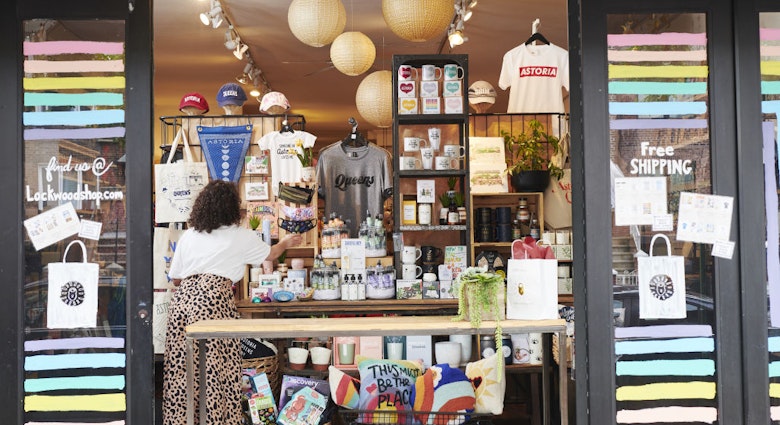
Nov 10, 2024 • 8 min read
The Quilt Capital of the World and one of just six Unesco Creative Cities in the USA, Paducah celebrates its folk arts heritage in delightful ways. The creative vibes that flow through this Western Kentucky town go way beyond bedspreads. Discover a little city that's full of big surprises.

First stop on any Paducah itinerary? The must-see . Check any preconceived notions you might be harboring about little old ladies sewing in sleepy circles at the door. The museum’s three galleries of fine-art caliber exhibits exceed what you might expect to find in much bigger museums. At first glance, you’ll swear the quilts hanging on display are actually photographs, or perhaps stained glass or oil paintings, until you draw close enough to see the fine stitching and appreciate the craftsmanship that goes into making these jaw-dropping beauties. It’s also fun to read the diverse bios and backstories of the creators on the plaques next to each piece.
After politely making your acquaintance with Paducah’s fiber art culture, here are three areas of town you’ll want to spend some time discovering.

Settlers arrived in Paducah around 1815, but it wasn’t until General William Clark purchased 37,000 acres of local land for the bargain price of $5 in 1827 that the town officially began to take shape. Easy transport via the Tennessee and Ohio rivers – and, later, railroad commerce – fed the growth through the city's incarnations as a Civil War battlefront, atomic energy production site, artists colony and more. Read all about this diverse history during a leisurely three-block stroll along the 50 hand-painted that now frame the riverfront, each depicting a different historical scene from Paducah’s past.
The new welcomes travelers to town by water, and is quickly becoming a popular Great Loop port stop. Development plans are underway to connect the well-frequented , a scenic 4.6-mile pedestrian-bike path linking two city parks, to the foot of Broadway St at the heart of downtown. Small businesses in character-rich 19th-century buildings line the brick-paved streets here – art galleries, theaters and storefronts. Fuel up for adventures with coffee, sandwiches and pastries at , an old-school Paducah mainstay since 1873. Or reward yourself at the end of the day with a glass of wine to accompany wood-fired pizzas, steaks and pastas in a romantic courtyard setting at .
As much as they appreciate Paducah’s history and heritage, local movers and shakers also like the town’s community spirit and creative energy, which make it a welcoming home for forward-thinking new projects and developments. An industrial-chic merger of art showroom and boutique accommodations, looks like something straight out of Midtown Manhattan. Next door, chef Sara Bradley has transformed an old railroad facility into , a sleek yet rustic showplace for her seasonal plates of modern Southern farm-to-table fare.

Things didn’t look good for Lower Town a couple of decades ago. The oldest neighborhood in Paducah was seriously struggling until the late 1990s, when an innovative artist relocation program began offering grants to reinvent languishing residential properties as funky live/work spaces. Now, the 25-block thrives: eclectic galleries, collectives and studios fill the gorgeously rehabbed Victorian homes.
Everything old is new again at the recently restored house, populated by the sustainable lifestyle boutique and craft cocktail bar. is a Lower Town staple, keeping the community caffeinated with organic, fair-trade coffee and tea for more than a decade.
A major neighborhood anchor, the provides a home for regional, national and international art exhibits in the Ford Gallery, as well as Master Artist Workshops and a community education series. The school's open to the public, gives culinary students a chance to serve up freshly made soups, salads, sandwiches and main dishes in a cafeteria-style setting. Plans for an interactive art park are in the works.
Feeling crafty? conducts a slate of creative workshops led by nationally recognized instructors, and also maintains drop-in space furnished with all the supplies you need to compose a DIY masterpiece.
The artists of Lower Town host special open houses and events during the annual each May, in addition to other gallery exhibits and studio openings throughout the year.

A few miles east of downtown on Broadway to Midtown, local businessman Ed Musselman has spent the last few years bringing the city’s landmark back to life through a painstaking top-to-bottom renovation. Locals are thrilled to see the neon lights back on, and the historic building is now a cozy home for (the name references a catastrophic flood that hit Paducah in 1937), , , the music studio, Paducah’s second location and several other local businesses.
Even chain restaurants often take a local angle in Paducah. – also in the Coke building – plays into Paducah’s creative culture with exhibits by local artists and a rotating display curated by the . Make a point to check out the , a vintage cigarette machine that’s been converted to vend small-scale original works of art.
While the Coke Plant is certainly a driving force behind Midtown’s economic renaissance, neighbors like , , and restaurant are getting into the act as well. The extensive roster of businesses here has created a well-rounded shopping and dining experience.


Nov 10, 2024 • 8 min read

Nov 13, 2024 • 7 min read






